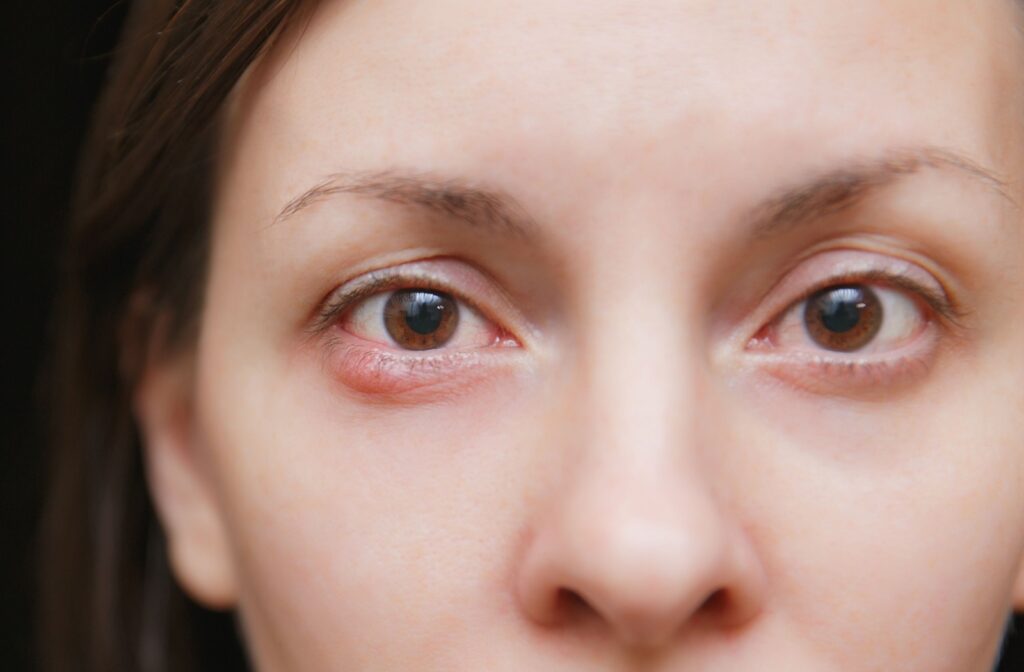While makeup is a central part of many people’s daily routine, it’s common to hear concerns about whether our beloved cosmetics might contribute to unpleasant eye issues, such as styes. These painful, unsightly bumps can suddenly appear and cause significant discomfort, so it’s natural to wonder about their origin.
Makeup can increase your risk of styes, but not everyone who wears makeup will develop a stye. Like anything, proper care is essential and your optometrist can help you manage symptoms with an eye exam if they do arise.
What Are Styes?
Styes, medically known as hordeolums, are painful, red bumps that form on the edge of the eyelid. They are often mistaken for pimples, but styes are infections of the eyelid’s oil glands. These infections are usually caused by the bacteria that normally reside harmless on your skin reaching your eyes. When these bacteria enter the oil glands near the eyelashes, they can trigger an infection that leads to a stye.
There are 2 types of styes:
- External Stye: External styes occur on the outside of the eyelid and are more common. They’re typically due to an infection in an eyelash follicle and can appear on either the top or bottom eyelid.
- Internal Stye: Internal styes occur when an oil gland inside the eyelid gets infected. This type can be frustratingly painful since the bump will be facing your eye.
Styes typically develop quickly and can cause significant discomfort. They might be accompanied by symptoms like:
- Redness
- Eyelid crust
- Watery eyes
- Eyelid swelling
- Light sensitivity
- Soreness
- Feeling like something is stuck in your eye
- Blurred vision
Factors that can increase your risk of developing a stye include:
- Rubbing your eyes
- Skin conditions like blepharitis, rosacea, or dandruff
- Eye allergies
- Wearing makeup overnight
- Diabetes
Misconceptions About Styes
Many misconceptions surround styes, often leading to confusion and ineffective treatments. One common myth is that styes are only caused by poor hygiene. While inadequate hygiene can contribute to styes, it’s not the sole cause. Even people with meticulous eye care routines can develop styes if bacteria enters the oil glands.
Another misconception is that styes are contagious. Unlike conditions such as conjunctivitis (pink eye), styes cannot spread from person to person through normal contact. However, the bacteria responsible for styes can spread from one eye to the other or be transferred through infected makeup if you don’t follow proper hygiene practices.
Lastly, some people believe that all styes can be treated effectively at home without professional intervention. While mild styes often resolve on their own with warm compresses, persistent or severe cases may require medical attention.

Makeup & Styes
The question of whether makeup can cause styes is a common concern among cosmetic users. The answer lies in understanding how makeup interacts with the delicate skin around the eyes. Makeup products, particularly those applied close to the lash line, can introduce bacteria into the oil glands, potentially leading to infections.
Certain makeup practices can increase the risk of developing styes. For example, expired makeup products can harbor bacteria, while sharing makeup tools with others can transfer bacteria from one person to another. Additionally, not removing makeup properly can leave a residue that clogs the oil glands, creating a breeding ground for bacteria.
Good Makeup Practices for Eye Health
You can still rock your new eyeliner without worrying about styes, it just takes a bit of extra care. Here are some tips for your cosmetic routine:
- Cleanliness is Key: Always wash your hands before applying makeup to avoid transferring bacteria from your hands to your face. Additionally, ensure that your makeup brushes and tools are cleaned regularly. Dirty brushes can accumulate bacteria and spread it to your eyes.
- Choose Quality Products: Investing in high-quality, reputable makeup products can make a significant difference in preventing styes. Check the expiration dates on your makeup items and discard any products that have passed their prime. Using expired makeup increases the likelihood of bacterial contamination.
- Remove Makeup Thoroughly: Proper makeup removal is crucial for preventing stye formation. Use a gentle, oil-free makeup remover to cleanse your face thoroughly before bedtime. Pay extra attention to the areas around your eyes, ensuring no residue is left behind. This practice helps keep the oil glands clear and reduces the risk of bacterial buildup.
- Avoid Sharing Makeup: While it may be tempting to share makeup products with friends, it’s best to avoid doing so. Sharing makeup tools, such as mascara wands or eyeliner pencils, can transfer bacteria between individuals, increasing the likelihood of stye formation. Stick to using your own products to maintain good hygiene.
- Be Mindful of Eye Makeup: When applying eye makeup, be cautious not to apply products too close to the lash line. Eyeliner and mascara should be applied carefully to avoid clogging the oil glands. Opt for hypoallergenic makeup products, as they are less likely to cause irritation or blockages.
Don’t Let Styes Cramp Your Style
While makeup can potentially contribute to the development of styes, adopting proper hygiene practices and using quality products can significantly reduce this risk. If you find yourself dealing with a persistent or painful stye, our professional team at Total Vision Campbell is ready to help! We can examine your symptoms, determine the cause, and get your eye health back on track.
For personalized advice and treatment options, book an appointment today. Remember, healthy eyes are beautiful eyes!



